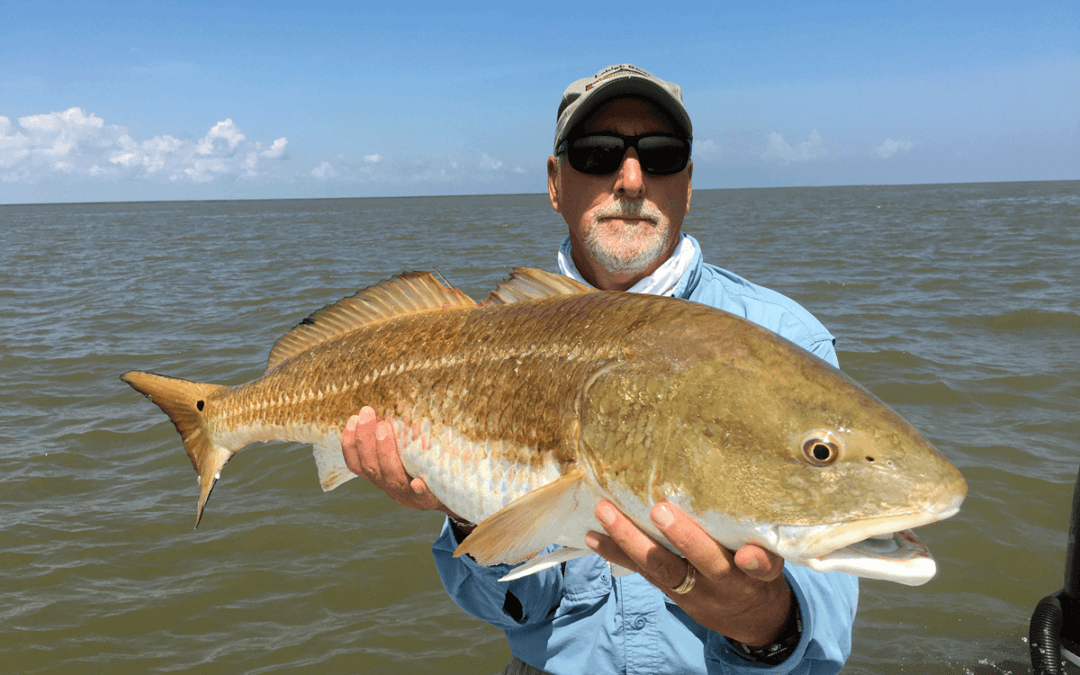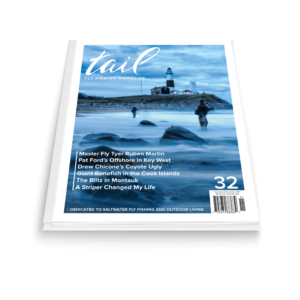An Excerpt for the Book, Fly Fishing the Southeast Coast
words and pictures by Gordon Churchill (originally published in Tail #33)
Feature image by Michael Roth
Old-timers in North Carolina call them puppy drum or red drum. They’re spottail bass in South Carolina, a red bass in North Florida. Whatever you call them, when you fly fish for reds in southern low-country areas, the first thing to understand is that the water is not crystal clear like you see on the fishing shows. You won’t be able to see the bottom much of the time. Recognize too, if you just blindly throw along the banks the same way a tournament angler would with a spinning rod, you are going to be disappointed. You must fish where you can see them, which means understanding tides and what they do to the water where the reds live.
It’s All About Shallow Water
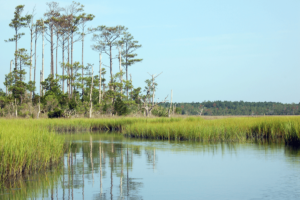 Let’s say you want to catch a redfish on a fly. The best way to do this is by hiring a guide. You call up the one you saw on a fishing show. That seems smart enough because he has lots of pictures on his website of people holding redfish. He must be good, right? He takes you out in his bay boat, blasting across the river to what must be his secret spot. He drops down his trolling motor and instructs you to cast to the bank. So you cast. And you cast. And you cast. You do not catch a redfish. You catch a small speckled trout and a flounder, which he says is a great day.
Let’s say you want to catch a redfish on a fly. The best way to do this is by hiring a guide. You call up the one you saw on a fishing show. That seems smart enough because he has lots of pictures on his website of people holding redfish. He must be good, right? He takes you out in his bay boat, blasting across the river to what must be his secret spot. He drops down his trolling motor and instructs you to cast to the bank. So you cast. And you cast. And you cast. You do not catch a redfish. You catch a small speckled trout and a flounder, which he says is a great day.
First, any water around here that’s deep enough to run a trolling motor is generally too deep to be fly fishing for redfish. If you can’t see the bottom, you can’t see the fish. If you can’t see the fish, you likely aren’t going to catch any either. That’s not to say you will never catch a redfish by blind casting with a fly rod because it happens. I’ve done it myself, but not often and not with any other idea than just doing something for a little while until the tide moves.
TIDES CREATE THE PERFECT WATER DEPTH
To catch a redfish on a fly in the low country from North Carolina to North Florida, you must fish one of two tides, either a negative low or an extreme high. What’s a negative low? Find the week around the full moon for this month. Then look at the low tides. There should be a number next to the time. That number represents the amount of water there will be at the peak (high) or nadir (low) of that tide. A great smartphone app is Aye Tide, but there are plenty out there. Make sure it shows tide height as well as tide time.
If there is a negative sign next to the low tide, that is a negative low. When that occurs, the water will be so low that there are only a few places for the fish to hold. The water there will be so shallow that when the fish move around to feed, you’ll be able to see them. That of course presupposes there will be redfish in the place you look.
Remember, I also said an extreme high, which probably seems counterintuitive. But the high tide fishing presents a different set of fishing circumstances entirely, which has become legendary since it was pioneered in South Carolina. The extremely high water will allow the redfish access to the fiddler crab flats on top of the spartina marshes that exist on either side of a creek or river. This occurs from Beaufort, North Carolina, down to Jacksonville, Florida. If you look at the areas behind the creek banks, there will be very tall grass on the edge, with short grass behind it. It weaves together to create a firm bottom that the small, quarter-sized crabs can’t disappear into, and there are a lot of them.
When the conditions are prime and the water gets deep enough, which happens about six to ten days per month from spring through early fall, the reds will belly up to this crab buffet. These are the famous “tailing redfish” that fly anglers talk about. Tails and backs will be exposed, allowing you to see the fish as they swim and feed. It is extremely visual, very addicting, and heart pounding, causing anglers to make plans months in advance.
The Right Boat
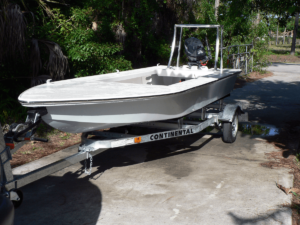 You may have surmised by now that you can’t hunt redfish in just any kind of boat. A standard center console bay boat draws too much water to fish at low tide, while at high tide you are limited to wadeable areas near where you anchor the boat. Also, some flats aren’t hard but are covered with “puff mud,” soft layers of muck that are nearly impossible to wade. If you wade, watch out for gray, grassless spots and test questionable areas. It’s awful stuff too: ask my wife how my wading shoes smell.
You may have surmised by now that you can’t hunt redfish in just any kind of boat. A standard center console bay boat draws too much water to fish at low tide, while at high tide you are limited to wadeable areas near where you anchor the boat. Also, some flats aren’t hard but are covered with “puff mud,” soft layers of muck that are nearly impossible to wade. If you wade, watch out for gray, grassless spots and test questionable areas. It’s awful stuff too: ask my wife how my wading shoes smell.
A canoe or kayak draws the right amount of water, but you are limited to marshes near the access area where you launch. Your fishing window is short so you want to maximize your time. The best boat for this type of fishing is a poling skiff.
Notice I did not say a “flat-bottom” boat. The popular skiff of the Carolinas makes too much noise that spooks the fish the first time the water smacks off the gunwale. A well-designed poling skiff moves swiftly, surely, and almost silently when poled in the shallows. It allows you to creep within casting range, sometimes so close the fish are under your feet while you gape down at them.
Tackle For Redfish
An 8-weight fly rod is the best choice. It allows you to cast the buggy, leggy flies that redfish seem to like, and it also has the power to beat the wind on breezy summer evenings. A substantial reel with a sealed drag capable of holding around 100 yards of 30-pound dacron backing is necessary because a hooked red will zoom off, heading for deep water. A good drag helps slow down and then turn the fish. A floating line is an obvious choice for the very shallow water conditions and generally, a 9-foot tapered leader ending in 12-pound tippet will work. If the fish are spooky, you can go up to a 12-foot leader.
Any fly that looks like a shrimp or a crab will most likely get bitten if presented correctly. Make sure, however, that you take your conditions into account. If fishing the low tides, the water will be murky, making it hard for the fish to see your offering. Pink, orange, and bright green are good fly-color choices. To make the hook ride point up, I often use a bend back–style tie. Some guides like flies with lead eyes, which also turn the hookup. 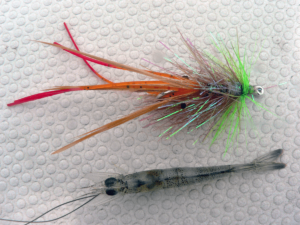
On the flats where the spartina sticks up six to 24 inches above the water, a weedless fly keeps it from hanging up on the retrieve. I have experimented a good deal and found that the double-post mono weed guard is the best choice. Lately, I have been tying on hooks normally used by freshwater bass anglers to fish plastic worms. They ride hook point up and the bend near the hook eye acts as a weed guard without deflecting strikes from fish.
Finding Fishy Locations
To locate flats and lots of spartina creeks, use online mapping and satellite photo apps or ask around. Those areas are where you will find the fish. Check tide charts to find the highest and lowest tides during the summer months. Determine areas that may be right for fly fishing by watching the water and studying the surroundings. Conversely, if you go out at low tide, you may be all alone in the same spot that is shared by three boats at high tide. Then you can see those fish busting shrimp in four inches of water that the bay boat guys never see.
Red fishing with a fly rod is generally not a numbers game. Yes, you may find a school penned up in a creek somewhere and catch a dozen or more. Mostly it’s a game of one here and another there. Lure anglers and bait guys won’t understand what you’re so excited about when you tell them about the “tailer” you saw on the grass flat that took a small shrimp fly. They’ll ask how many you caught and when you say that’s the only one, they will look at you funny. It’s all good. Fly fishing is about the how, not the how many.

